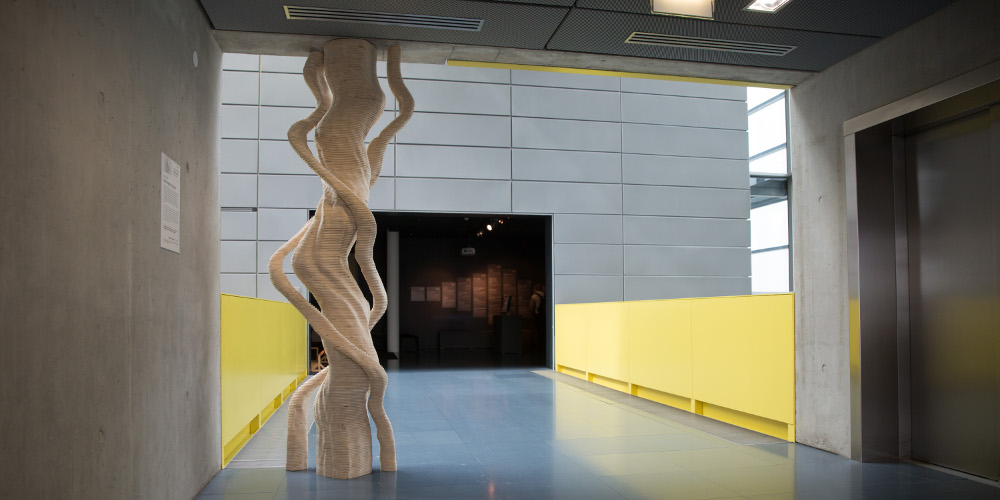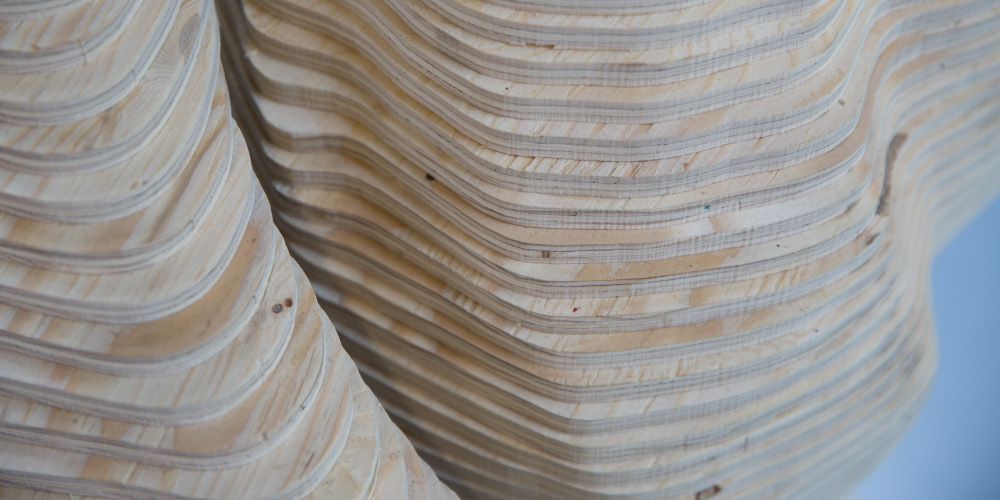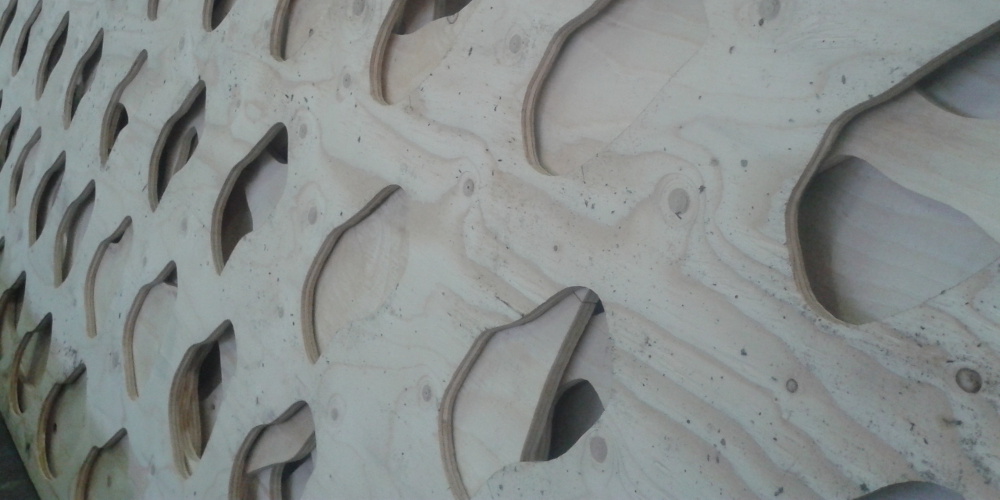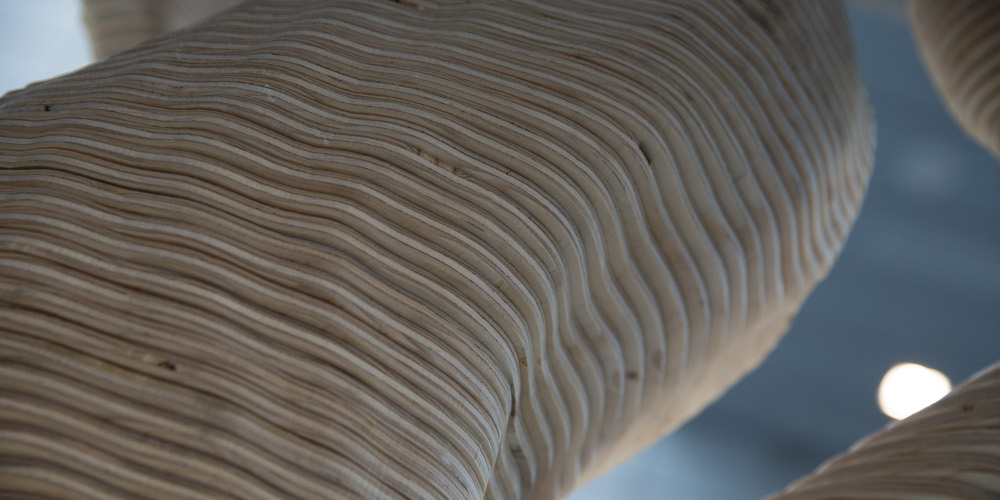Daniel Crooks came back to the Ars Electronica Futurelab to produce a room-high “Real Imaginary Object” out of plywood for the Ars Electronica Festival. Similarly to the first residency this second visit has been supported by the Australian Council for the Arts. After his residency at the Ars Electronica Futurelab in spring he kept on working on refining the tracking system and the 3D-modeling of his “Real Imaginary Objects” to produce the first objects for an exhibition at a gallery in Melbourne. The room-high artwork that has been produced for the Ars Electronica Festival was the first one made of plywood. Through this technique, showing the slices of the wood that have been stapled one on the other, it represents the idea of manifesting time in space through taking slices of the recorded object over time in an even more explicit way than the 3D printed ones.
In an interview, Daniel talks about his idea to produce a 3D object from a fragment of a temporal sequence, about the development of the first prototypes during his residency at the Ars Electronica Futurelab and about the presentation of the finished “Real Imaginary Object” during the Ars Electronica Festival.
Could you please give us a short overview of what your Residency at the Ars Electronica Futurelab was about?
Daniel Crooks: My residency at the Futurelab was about trying to develop a new kind of camera, a 3D slicing data camera. The idea was to capture a sequence of cross sections or 2D ‘frames’ that could then be accumulated into a 3D model, a kind of time-stack, where the 3rd dimension is temporal.
In your presentation in the Deep Space you talked about the treatment of time itself as a medium…
Daniel Crooks: Yes, this is one of the central strategies in my practice. So, I’m really trying to think of time in physical terms, as tangible and malleable. With respect to the moving image it can be helpful to think of a video as a stack of individual frames placed on top of each other. This stack becomes of volume of time that you can then start to think of alternate ways to navigate.
Claudia Schnugg: This development, to create a three dimensional objects from changes of physical three dimensional objects over time (e.g., how objects, arms or legs change while moving through a room) is extremely interesting if you think of Daniel’s work in its bigger context. He first developed static pictures that show how slices of the world change over time. Based on that he developed videos that were able to demonstrate time through this technique in a way that addresses more senses. Real Imaginary Objects is now the next step, where Daniel develops sculptures that show time as manifestation in the real world that can be touched and viewed from any perspective.
How did you priduce the “Real Imaginary Objects”?
Daniel Crooks: Otto Naderer, member of the Ars Electronica Futurelab, and I tested a variety of different depth sensing technologies and then developing the software to combine the separate views. Otto already had a lot of experience working in this area and so we were able to work up some testing prototypes fairly quickly using laser range finders and Kinect cameras. The tricky part was how to take the raw depth data and ’surface’ it into clean 3D models and this stage in the process was far from straightforward.
How did your project develop from this stage to the great pieces we saw at the Ars Electronica Festival?
Daniel Crooks: Basically I left Linz with a lot of data but no really clear way of turning the data into physical objects. I wouldn’t say it was unsatisfying just that I wasn’t quite as far down the path of a fully realised production pipeline as I had hoped to be. When I got back to Melbourne I spent a good deal of time exploring software options for making sense of the point clouds we’d captured. Otto and I had managed to align the scanner array as best we could but it was still a long way from perfect which meant in the end there was a huge amount of manual labour to stitch the recorded data into useable meshes. From there it was a little more straightforward to output the objects, though the large plywood version did present a number of extra issues.
How was it to come back to Linz and to set up your “Real Imaginary Objects” at the Festival?
Daniel Crooks: It was great to come back to Linz and present some tangible outcomes from my residency. I was very keen to try assembling the large wooden sculpture and was also particularly intrigued to see how the smaller objects would read outside the white cube of the gallery space.
How are you satisfied with the outcome?
Daniel Crooks: While the utilitarian spaces of the high school corridors were really interesting (and aesthetically quite beautiful) I think the context didn’t entirely work for these particular objects. The feedback I received though was overwhelmingly positive and the extended installation of the large plywood work in the Ars Electronica Centre is fantastic.
What are your next steps?
Daniel Crooks: There’s still a long way to go. The next step is to refine the calibration and alignment of the scanning system so that the ‘stitching’ of the separate views can be more automated. Once that is established I need to expand the scanning envelope to capture larger movements and groups of people. Ultimately I want to make room sized installations with sinuous fluid objects filling the space but the possibility of that is still a way off so, who knows, I might even have time to squeeze in another Futurelab residency!
Talk of Daniel Crooks at the Ars Electronica Residency Network Panel, at Ars Electronica Festival 2014: http://talksandlectures.aec.at/?id=348





